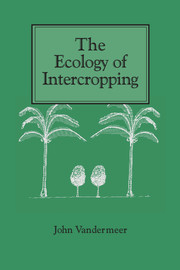Book contents
- Frontmatter
- Contents
- Preface
- 1 Introduction: intercrops and ecology
- 2 The measurement of intercrop performance
- 3 The competitive production principle
- 4 Facilitation
- 5 Mechanisms of the competitive production principle
- 6 The environments modified to produce facilitation
- 7 Special problems in intercrops involving perennials
- 8 Weeds and intercrops
- 9 Variability and intercrops
- 10 Planning intercrops – a phenomenological approach
- 11 Planning intercrops – a mechanistic approach
- 12 Critical research directions for the future
- References
- Author index
- Subject index
2 - The measurement of intercrop performance
Published online by Cambridge University Press: 05 August 2012
- Frontmatter
- Contents
- Preface
- 1 Introduction: intercrops and ecology
- 2 The measurement of intercrop performance
- 3 The competitive production principle
- 4 Facilitation
- 5 Mechanisms of the competitive production principle
- 6 The environments modified to produce facilitation
- 7 Special problems in intercrops involving perennials
- 8 Weeds and intercrops
- 9 Variability and intercrops
- 10 Planning intercrops – a phenomenological approach
- 11 Planning intercrops – a mechanistic approach
- 12 Critical research directions for the future
- References
- Author index
- Subject index
Summary
Is there an advantage to growing intercrops? The simplest answer to this question is the qualitative one. If so many traditional agriculturists do it, there must be some advantage to it. This attitude is fine at the most general level, and we really need go no further. But at a more specific level we wish to ask the question about particular intercropping systems. Is it or is it not true on a particular farm in northern Brazil that corn grown together with peanuts is better than corn grown alone and peanuts grown alone? That is the question on which we focus in this chapter.
The bases for comparison
The problem of population density and planting design
Whatever the method of evaluation, the underlying basis is always a comparison of the performance in intercrop to the performance in monoculture. The first complication arises when one must decide what monoculture production figures should be used in the evaluation. In Figure 2.1 several possibilities are illustrated. In Figure 2.1 (a), the polyculture is stipulated first, and we are to decide which monocultures to use for the computation of the land equivalent to ratio (LER). If we use case I, the overall population is the same in monoculture and intercrop. If we use case II, the overall population density is larger in the intercrop than it is in the monocultures. Consider the similar Figure 2.1 (b). In this case we begin with the monocultures as stipulated, and are to decide which intercrop to use.
- Type
- Chapter
- Information
- The Ecology of Intercropping , pp. 15 - 28Publisher: Cambridge University PressPrint publication year: 1989
- 1
- Cited by



